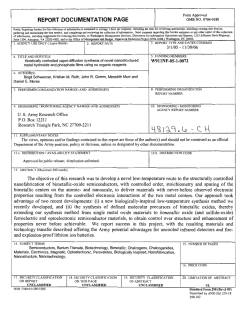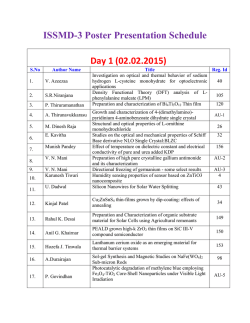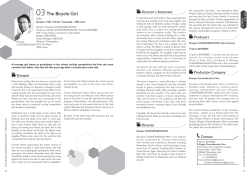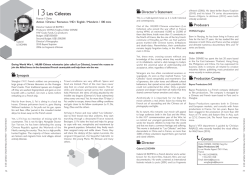
cracking and its effect on the electrical charging/discharging in
46th Lunar and Planetary Science Conference (2015) 2956.pdf CRACKING AND ITS EFFECT ON THE ELECTRICAL CHARGING/DISCHARGING IN AMORPHOUS SOLID WATER DUE TO THE DESORPTION OF UNDERLYING XENON GASES. C. Bu and R. A. Baragiola, University of Virginia, Laboratory of Atomic and Surface Physics, Charlottesville, VA 22904, USA [[email protected]]. Introduction: Ground observations and space missions have revealed that water ice is abundant in astronomical environments such as comets, satellites of the outer planets and their rings [1], and icy grain mantles in dense interstellar clouds [2]; thus, we investigated the properties of water ice at very low temperatures [3]. Condensation of water vapor onto cold substrates (< ~130 K) in vacuum forms amorphous solid water (ASW) and serves as a laboratory analog of the icy surfaces existent in the space environment. The absorption, retention and desorption of volatile gases within an ASW matrix are fundamental processes that have been investigated in earlier studies, and the results were used to explain several cometary phenomena [4], the possible ejection of ice grains in Enceladus [4], and the surface composition in icy satellites such as Ganymede [5]. Cracks in the water ice due to desorption of volatile gases were identified in the earlier studies [4 – 6]. Bombardments of energetic ions and photons on icy bodies such as Ganymede, together with photoelectron, secondary electron, and secondary ion emission, will leave the icy surfaces charged. The charged surfaces can deflect or even reflect magnetospheric particles, changing the photolysis and radiolysis on the surfaces. In this work, we address the relationships between surface microstructure (cracks) due to the gas adsorption/desorption in ASW and electrical properties of ASW at low temperatures (< 150 K). Experiments: Experiments were performed in an ultra-high vacuum system (base pressure: ~2 × 10-10 Torr). Films were deposited by directing collimated vapor beams onto a liquid-helium cooled, gold-coated quartz crystal microbalance (QCM). Xe films were deposited at 40 K at normal incidence, annealed at 60 K, and cooled to 10 K. ASW films were deposited at 10 K at 45° incidence. The porosity of the ice films was calculated by combining the column density obtained from QCM measurements and the thickness derived from UV-visible interferometry [6]. Film surface potentials (Vs) were determined using a Kelvin probe to measure the contact potential difference (CPD) [7]. Surface microstructures, cracks larger than a few μm, of the films were imaged with a longdistance microscope. To study the effects induced by the desorption of the Xe gases, we focused on the double-layer films consisting of 1120 ML ASW on top of 710 ML Xe. For comparison, we also prepared single-layer ASW films (1120 ML) and Xe films (710 ML), and/or switched the order of the double-layer films by depositing the 710 ML Xe films at 10 K on top of the 1120 ML ASW films. To investigate the surface electrostatic charging/discharging in ASW, we deposited charge onto the films by irradiating with 500 eV He+ ions at normal incidence for 270 seconds to a fluence of (0.9 ± 0.1) × 1012 cm-2 s-1. All of these films were heated from 10 K to 200 K at a rate of 1.8 K/minute while monitoring the surface microscopic structure, surface potentials, total mass loss due to desorption derived from the QCM measurements, and temperature programmed desorption (TPD) spectra obtained with a quadrupole mass spectrometer (QMS). Results and Discussions: At 10 K after the growth of the films, no cracks were observed in all the films. Surface potential measurements of the double-layer films indicated that the Xe layer, regardless of the position, didn’t affect the electrical properties of the ASW layer. During heating the films from 10 K to 200 K, we observed the evolving surface microstructure, surface potentials, and desorption spectra (TPD) as a function of temperature. Cracking: Cracks were only observed in the double-layer films where ASW films were deposited on top of Xe films. Cracks appeared at (44±1) K and continued to evolve until ~74 K (Figure 1). We suggest that the cracking and its evolution is induced by the Xe desorption through the water ice overlayer, by coordinating evolutions of the cracks and the TPD spectra. 46th Lunar and Planetary Science Conference (2015) 2956.pdf mogeneous surface electric fields may deflect and even reflect particles with the same polarity from reaching the surfaces of the icy bodies and must be considered when modeling plasma-surface interactions. References: [1] Dalton, J. B. et al. (2010), Space Sci. Rev. 153, 113 – 154; [2] Ehrenfreund, P. et al. (2000), Adv. Space Res. 25, 2177 – 2188; [3] Baragiola, R. A. (2003), Planet Space Sci. 51, 953–961; [4] Bar-Nun, A. et al. (1985), Icarus 63, 317– 332; [5] Baragiola, R. A. (1998), JGR, 103, 25865 – 25872; [6] Westley, M. S. et al. (1998), J. Chem. Phys. 108, 3321–3326; [7] Shi, J. et al. (2012), Phys. Rev. B 85, 035424 Figure 1 Evolution of cracks with annealing temperature in the double-layer film consisting of 1120 ML ASW atop a 710 ML Xe. The field of view was 700 μm ×700 μm. Electrical properties: Surface potentials of the irradiated double-layer films, regardless of the layer order, showed new features above ~44 K (Figure 2). Our results indicate that a fraction of the deposited charges were trapped in the crack-induced defects and/or at Xe-H2O interface traps. These trapped charges decayed at higher temperatures. Figure 2 Evolutions of the surface potentials (solidlines) with annealing temperatures in the irradiated films. Compared to the single-layer ASW or Xe films, new features were observed in the double-layer films. Xe desorption peaks for the double-layer film with ASW atop of Xe (dot-line) were also presented. Conclusions: Studies here show that the desorption of gases from volatile underlayers beneath amorphous solid water ice results in fractures within the water ice. Surface potential measurements indicate that a fraction of charges are trapped in cracks and interface traps, creating surface electric fields. Inho-
© Copyright 2025






